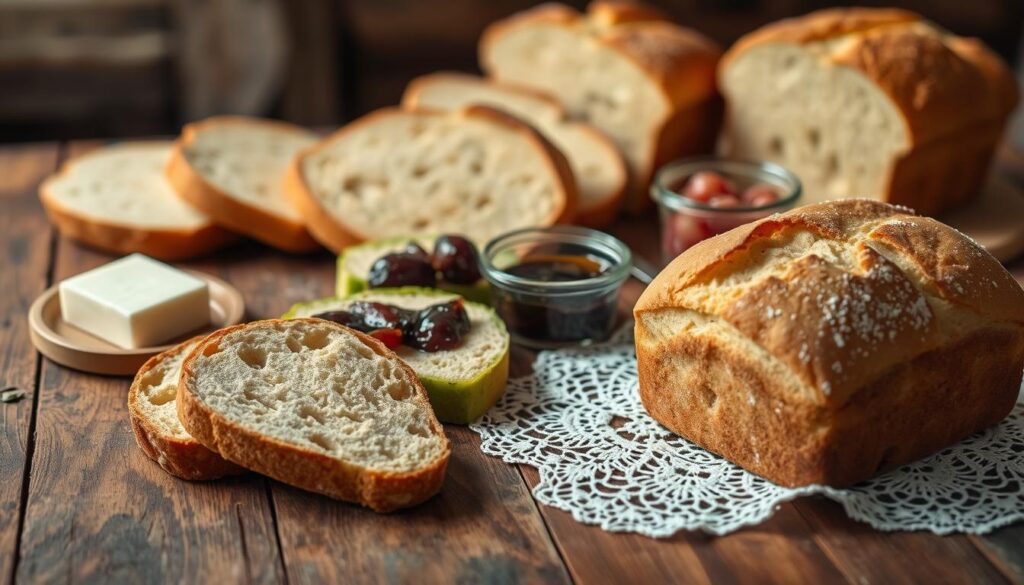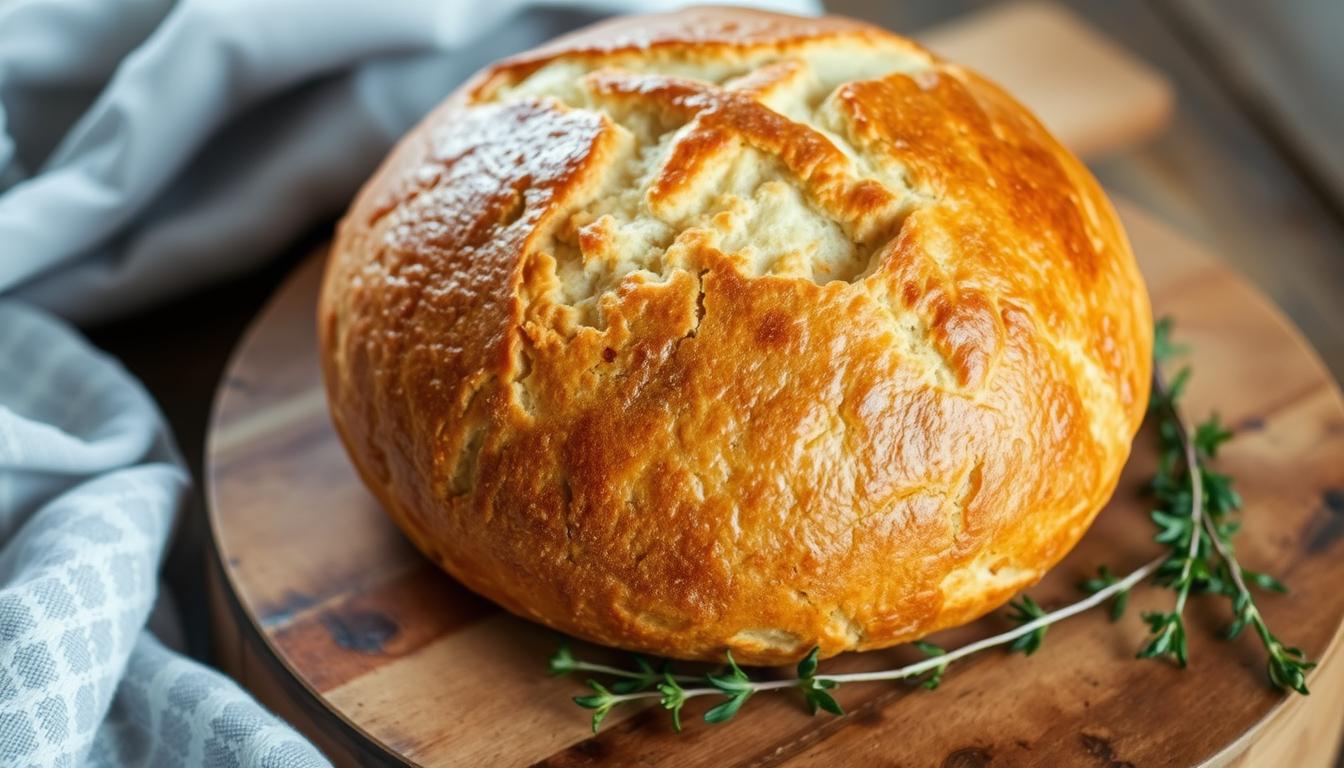Every St. Patrick’s Day, my grandmother’s kitchen would fill with the warm, comforting aroma of Irish soda bread. The memories of her hands expertly mixing ingredients, creating a rustic loaf that connected us to our Irish roots, remain vivid and cherished. Irish soda bread is more than just a recipe—it’s a culinary tradition that tells a story of resilience, simplicity, and family.
This beloved quick bread represents the heart of Irish cuisine. It’s a testament to the ingenuity of Irish home cooks who transformed basic ingredients into something magical. Unlike traditional yeasted breads, Irish soda bread relies on baking soda and buttermilk for its rise. This makes it a simple yet delicious staple that has sustained families for generations.
Key Takeaways
- Irish soda bread is a quick bread with deep cultural significance
- No yeast is required for this traditional recipe
- Perfect for celebrating St. Patrick’s Day
- Simple ingredients create a delicious, rustic loaf
- Connects home bakers to Irish culinary heritage
Understanding Irish Soda Bread’s Heritage and Significance
Irish soda bread is more than a food; it’s a symbol of Irish heritage. It tells a story of resilience and innovation. It came about in the 19th century, during hard times in Ireland.
The bread’s story began out of necessity. When yeast was hard to find, Irish families found a clever solution. They used baking soda and buttermilk to make bread rise, without expensive ingredients.
Origins in Irish Culinary History
Irish soda bread became a staple in the mid-19th century. It showed the resourcefulness of Irish households. The recipe includes:
- Soft wheat flour
- Baking soda
- Salt
- Buttermilk
Cultural Importance During St. Patrick’s Day
Today, Irish soda bread is a beloved tradition, celebrated on St. Patrick’s Day. It symbolizes community and cultural pride. It connects generations through its simple yet meaningful making.
Traditional Family Recipes Through Generations
Families have shared their unique soda bread recipes for years. Each recipe has its own twist, showing regional and personal preferences. Some add raisins, caraway seeds, or use different flours.
| Ingredient | Traditional Role | Cultural Significance |
|---|---|---|
| Baking Soda | Leavening Agent | Replaced expensive yeast |
| Buttermilk | Liquid & Acid Activator | Enables bread to rise |
| Wheat Flour | Base Ingredient | Reflects local agricultural practices |
By keeping this recipe alive, Irish families honor their culinary heritage. They turn a simple bread into a powerful link to their roots.
Essential Ingredients for Perfect Irish Soda Bread
To make authentic buttermilk bread, you need the right ingredients. Each one adds to the classic Irish taste. Start by knowing how each part works in your recipe.
High-quality flour is the base of Irish soda bread. You’ll need 4 cups of all-purpose flour for the right texture. Add dry ingredients like 1 teaspoon of baking soda and 1 teaspoon of salt. This ensures the bread rises well and tastes great.
- 4 cups all-purpose flour
- 1/4 cup granulated sugar
- 1 teaspoon baking soda
- 1 teaspoon salt
- 1/4 cup cold butter, cut into small pieces
Raisins add sweetness to the bread. You can use 1 1/4 cups of raisins. They make your soda bread even more special.
| Ingredient | Quantity | Purpose |
|---|---|---|
| Buttermilk | 1 3/4 cups | Provides moisture and helps activate baking soda |
| Egg | 1 whole | Adds richness and helps bind ingredients |
| Raisins | 1 1/4 cups | Optional sweet addition |
Buttermilk is key in baking soda bread. It makes the bread rise and gives it a soft texture. Make sure all ingredients are cold and fresh for the best results.
Pro tip: Keep your butter and buttermilk chilled until just before mixing to achieve the perfect texture in your Irish soda bread.
The Science Behind Buttermilk and Baking Soda
Irish soda bread is a quick bread marvel. Its unique texture and rise come from buttermilk and baking soda’s magic.
The reaction between buttermilk and baking soda is fascinating. It’s what makes this bread different from yeast-based ones. Knowing this science can change your baking.
Chemical Reaction That Creates Rise
Baking soda meets buttermilk’s acidity and changes everything. It creates carbon dioxide gas. This gas makes the dough rise and gives it a light texture.
- 1 teaspoon of baking soda generates significant rising power
- 14 ounces of buttermilk provides the necessary acidic environment
- The reaction occurs quickly, eliminating the need for traditional yeast
Why Cold Ingredients Matter
Cold ingredients are key for perfect quick bread. Cold butter and buttermilk keep fat pockets in the dough. This makes the bread flaky and tender.
Buttermilk Substitutes and Their Effects
Without buttermilk, you can use milk with vinegar or yogurt. They work as substitutes, providing the needed acidity.
Pro tip: When substituting buttermilk, maintain the same acid-to-base ratio to ensure proper rising.
Learning about Irish soda bread’s science boosts your baking. It shows the special chemistry behind this traditional bread.
Step-by-Step Guide to Making Irish Soda Bread
Making Irish soda bread is all about precision and care. It turns simple ingredients into a delicious loaf. This loaf captures the heart of Irish culinary tradition.

Before starting, get your ingredients ready and set up your kitchen. You’ll need:
- 4 cups all-purpose flour
- 1 ½ teaspoons salt
- 1 ¼ teaspoons baking soda
- 2 cups buttermilk
- Cold butter
For perfect soda bread, follow these steps carefully:
- Preheat your oven to 425°F (220°C)
- Whisk buttermilk with one egg in a separate bowl
- In another bowl, combine dry ingredients
- Cut cold butter into the flour mixture using a pastry cutter
- Add wet ingredients and mix gently
- Bring dough together with your hands – avoid overworking
- Shape into a round loaf
- Score the top with a deep “X” cut (about ¾ inch deep)
Baking time is key. Start at 425°F for 10 minutes, then drop to 375°F for 35-40 minutes. It’s done when it’s golden brown and hollow when tapped.
Pro tip: Let the bread cool for 15 minutes before slicing to ensure the perfect texture.
The magic of baking soda bread is in its simplicity and the care you put into each step. Enjoy your homemade Irish treasure!
Mastering the Perfect Texture and Crust
Making the perfect Irish soda bread needs focus and some baking tricks. You want a golden-brown outside and a soft inside. This captures the true taste of Irish soda bread.
Creating the Signature Cross
The cross on Irish soda bread is more than just a design. It helps steam escape and lets the bread grow evenly. It also holds a special meaning in Irish culture.
Achieving the Golden-Brown Exterior
For a great crust, try these tips:
- Preheat your oven to 400 degrees F
- Brush the loaf with buttermilk before baking
- Sprinkle coarse sugar crystals on top for extra crunch
Testing for Doneness
Check if your bread is done with these methods:
| Method | Technique |
|---|---|
| Tap Test | Listen for a hollow sound when tapping the bottom of the loaf |
| Temperature Check | Use a digital thermometer to confirm internal temperature of 190 degrees F |
| Visual Cue | Look for a deep golden-brown crust |
For the best Irish soda bread, mix gently and bake carefully. Don’t overwork the dough. This keeps it soft and tender, making it a joy to eat.
Traditional Variations and Modern Twists

Irish cuisine has exciting twists on the classic soda bread. Traditional recipes are loved, but now, bakers add new ingredients. These changes honor the bread’s rich history.
Regional variations show the bread’s diversity. Some add raisins for sweetness, while others use caraway seeds for flavor. These changes make the bread a unique culinary experience.
- Classic raisin-studded soda bread
- Caraway seed-enhanced traditional loaf
- Whole wheat flour variations
- Gluten-free adaptations
Modern bakers are creative with soda bread. You can try different flours, add nuts, or dried fruits. The goal is to keep the bread’s texture while trying new tastes.
| Variation | Key Ingredients | Baking Time Adjustment |
|---|---|---|
| Mini Loaves | Standard recipe | Reduce by 10-15 minutes |
| Whole Wheat | Whole wheat flour | Standard baking time |
| Fruit-Studded | Raisins or dried cranberries | Add 2-3 minutes |
Smaller loaves bake faster. Check them often and tap the bottom. A hollow sound means they’re done. Your soda bread journey is endless!
Serving and Storage Tips
After making your Irish soda bread for St. Patrick’s Day, knowing how to serve and store it is key. The right ways to keep it will let you enjoy every crumb of your homemade loaf.
When serving Irish soda bread, temperature and what you serve it with are important. Here are some tips from experts:
Best Serving Temperature
Irish soda bread is best when it’s slightly warm or at room temperature. For a true taste, try these serving ideas:
- Serve within 1-2 hours of baking for the best taste
- Pair with salted Irish butter or sharp Dubliner cheese
- Enjoy with local honey or homemade jam
Preservation Methods
Keeping the bread fresh is important. Here’s how to store it right:
- Store at room temperature for up to 2 days
- Wrap tightly in aluminum foil to keep it moist
- Put in a sealed plastic bag to keep air out
- Refrigerate for longer freshness up to 1 week
Freezing Instructions
Freezing your Irish soda bread lets you enjoy it even after St. Patrick’s Day. Here’s how to freeze and thaw it right:
- Cool bread completely before freezing
- Wrap in plastic wrap, then in aluminum foil
- Freeze for up to 3 months
- Thaw at room temperature for the best texture
- Refresh by warming in oven at 300°F for 5-10 minutes
Follow these tips to keep your Irish soda bread fresh and delicious. It’ll be ready to enjoy whenever you want.
Conclusion
Your journey into Irish soda bread connects you with a long tradition. It goes back to 1836. This bread is more than a recipe; it’s a piece of Irish heritage that brings families together, often on St. Patrick’s Day.
With just four basic ingredients, you can make a delicious loaf. It tells a story of resourcefulness and cultural pride. The bread’s simplicity shows the practical side of Irish cooking, where every ingredient had a purpose. Whether you’re a seasoned baker or new to the kitchen, making Irish soda bread is a fun way to explore a beloved tradition.
You can enjoy this versatile bread in many ways. Try it with hearty soups, spread butter on it, or pair it with fruit preserves. If you’re up for more, try Guinness Chocolate Cake or Baileys Coffee Cupcakes. These recipes add to your Irish cuisine celebration.
By learning and sharing this recipe, you join a story that connects generations and cultures. Your St. Patrick’s Day can become more than just a celebration. It becomes a meaningful exploration of Irish tradition through homemade soda bread.

